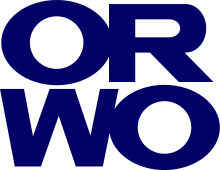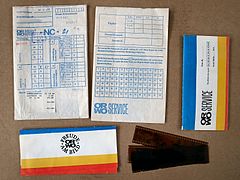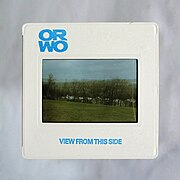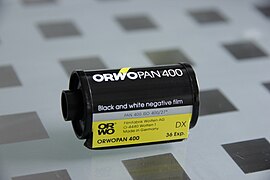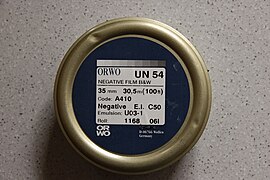Wolfen film factory
The Wolfen film factory in Wolfen (now Bitterfeld-Wolfen , Anhalt-Bitterfeld district ) was founded in 1909 by the Berlin company Agfa , which specializes in photo chemistry . After 1945 the film factory had - under the since 1964 brand ORWO ( acronym of Or iginal Where lfen) - the monopoly on film production in the GDR . In addition to films for photography , motion picture films , reprographic and X-ray film material , technical films and plates as well as magnetic tapes were produced.
The ORWO trademark continues to be used by several companies for photographic products.
history
For the history of Agfa AG see also: Agfa
1909 to 1945

The Wolfen film factory has belonged to the Aktien-Gesellschaft für Anilin-Fabrikation (Agfa) since it was founded in 1909 and was part of IG Farben from 1925 . In 1929, the Agfa-Filmfabrik Wolfen became the lead company of Division III within IG Farben and was thus responsible for the Agfa camera factory in Munich (formerly A. Hch. Rietzschel ), the Leverkusen photo paper factory and the Wolfen , Premnitz and Landsberg an der Warthe fiber factories .
In 1936, the Wolfen film factory produced the world's first practicable multi-layer color film , the Agfacolor Neu , which was developed by Gustav Wilmanns , Wilhelm Schneider and John Eggert . In the same year, the largest fiber factory in the world was built in Wolfen with funds from the German Reich . There, cellulose was produced on the basis of the local raw material wood , which was then processed into synthetic fibers. The best known synthetic fiber from Wolfen at this time was Vistra . The author Hans Dominik wrote the book "Vistra, the white gold of Germany" for the new product as part of an advertising campaign. In 1943, the Wolfen film factory started production of magnetic tape , which, for technical reasons , was relocated to Wolfen by BASF in Ludwigshafen am Rhein .
In May 1943, 250 female concentration camp prisoners were transferred from the central women’s concentration camp Ravensbrück to the newly established Wolfen subcamp of IG Farbenindustrie AG Filmfabrik.
End of war and post-war period
On April 20, 1945 the film factory was taken over by the US armed forces . This was followed by a systematic review by US and British experts. Until 1 July 1945 (the date of by the Allies agreed crew change, the Red Army of the Soviet Union ) were important documents such as patents , recipes , Directorate files and research diaries, specialty chemicals and precious metals seized. The expertise gained in this way was made available to the US photochemical industry. A few years later, Eastman Kodak offered a color film based on the Wolfener process. Paul Esselmann became director of the film factory. By SMAD order No. 156 of July 22, 1946, the Wolfen film factory passed into Soviet ownership and was assigned to the Soviet stock corporation (SAG) "Mineral Fertilizers". Many employees left the Soviet occupation zone for the west in order to look for a professional future in the Agfa factories there. In Wolfen, dismantling, ordered by SMAD, began in 1946, while production was confiscated for reparation reasons . 50% of the production facilities for the production of the color film were dismantled and taken to Shostka in the Ukraine to build the color film factory No. 1 in the Soviet Union. For this purpose engineers and masters from Wolfen were hired. Some traveled to the Soviet Union with their families to take over assembly and start-up of production.
The film factory in the GDR

It was later classified in the SAG “Photoplenka”, which included the entire Soviet raw film industry. On December 31, 1953, the film factory was released from SAG and now traded as VEB Film- und Chemiefaserwerk Agfa Wolfen. The chemical program decided by the GDR government in 1958 brought an expansion of the film and a reduction of the fiber division for Wolfen. In the same year Wolfen became a member of the newly founded Association of People's Own Enterprises (VVB) chemical fiber and photo chemistry .
Although the Agfa management had transferred all important patents to Leverkusen before the end of the war , the Leverkusen-based Agfa caused the east German counterpart major problems: The Wolfen film factory also sold its products with the Agfa trademark, which confused customers. Initially, the East German side took the position of being the legal successor of Agfa. However, this strategy had no chance in court because a Soviet joint-stock company could not be a successor. Surprisingly, the GDR government later did not insist on sticking to the brand name Agfa . Rather, she was of the opinion that the products made by socialists were of such high quality that they did not need a big name to find a market. In Wolfen, however, they did not want to do without the name. Without an agreement, however, there was a risk that the rights would fall to a third party. In 1956, for example, a trademark agreement was reached that was to apply until 1964. Accordingly, the Wolfen film factory was allowed to use the brand name in the Council for Mutual Economic Aid (RGW) and in friendly countries such as India, Leverkusen in the rest of the world with the exception of France and Yugoslavia. An international court should rule on these two countries. Nevertheless, East German Agfa products repeatedly made it to the West German markets. In 1964 the brand was changed from Agfa to ORWO in order to clearly differentiate itself from the West German Agfa, since 1964 Agfa-Gevaert.
When the VEB Fotochemisches Kombinat Wolfen was founded in 1970, the Wolfen film factory became its parent company. The founding members of the new combine were Fotopapierwerke Dresden , Fotopapierwerke Wernigerode , Gelatinewerke Calbe , Fotochemische Werke Berlin and the Lichtpausenwerk Berlin .
1990 to 1998
After the fall of the Wall in 1990, the photochemical combine was dissolved and the Wolfen parent company was converted into Filmfabrik Wolfen AG on June 13, 1990 . The Treuhandanstalt held their entire share capital of DM 230 million . In 1992, the Filmfabrik Wolfen AG was split up into the Wolfener Vermögensverwaltungsgesellschaft AG and the Filmfabrik Wolfen GmbH . The privatization of the Filmfabrik Wolfen GmbH failed. In 1994 the liquidation of the company was initiated. The new owner of the liquidation assets of Filmfabrik Wolfen GmbH was the photo industrialist Heinrich Manderman in autumn 1994 . He founded ORWO AG , which however also became insolvent in November 1997 . Parts of the film factory were then restructured in 1998.
Other remaining parts of the company are the fine chemicals manufacturers Organica Feinchemie GmbH Wolfen, Synthetica , FEW Chemicals GmbH, the Folienwerk Wolfen GmbH as a supplier for the optical, electronics and film industries and the special mechanics company MABA .
ORWO today
The brand only survived the fall of the Berlin Wall to a limited extent, but it still does. In addition to ORWO Net AG, Filmotec GmbH owns and uses joint usage rights for the ORWO trademark.
The ORWO Media GmbH entered the digital photo services industry. The production of chemical paint films, however, has been discontinued. ORWO Net GmbH was founded on September 25, 2002 . On October 1, 2003, she took over the operational business of the predecessor companies (PixelNet AG and its subsidiary ORWO Media GmbH) in the photo services sector and acquired the ORWO and PixelNet trademarks. After the shares were transferred to Drei GmbH (2004), the share capital was increased to 250,000 euros in 2005. ORWO Net AG was founded on October 2, 2007 by bringing in the shares in ORWO Net GmbH. On November 27, 2009 ORWO Net AG acquired the assets of the insolvent Foto Quelle GmbH, including the brands “Foto Quelle” and “Revue”. ORWO Net has been cooperating with Foto Quelle since 2005. In 2014, ORWO Net employed more than 300 people. In 2018 ORWO Net AG acquired the online business of Photo Dose from Bremen.
Filmotec GmbH has been producing film materials since 1998 . Technical films (such as duplicate films, copy films, audio negative films, leader films, surveillance materials and holographic films) as well as black and white recording films are produced in the Bitterfeld-Wolfen Chemical Park .
Products and processes
Both ORWO in the GDR and Agfa produced color films using the Agfacolor process developed in the 1930s (diffusion-proof color couplers). Agfa-Gevaert switched its film materials and photo papers from 1978 (color negative films) to 1985 (amateur color reversal films) to the so-called Eastman Color or Ektachrome process (oil-protected color couplers, for example C-41 , E-6 and their predecessors) , after which the films became compatible with Kodak, Fuji and others. ORWO prepared a conversion analogous to similar considerations in the USSR , but could no longer complete the conversion until the end of the GDR, which brought considerable disadvantages on the world market dominated by Kodak. The Agfa process had several disadvantages over the Kodak process. The dyes (color coupler) were slightly soluble in water, which extended washing times caused after fixing, moreover, a not lifted for the same reasons on the Kodak-level bath temperature prolonged development (25 ° C to 37.8 ° C). When pouring the materials, the Agfacolor process - again due to the properties of the couplers - only allowed the machines to run at lower speeds. In the eighties, research was carried out on new films based on the Kodak process. These were sold after 1989 as color negative film PR100 and QRS100, but could not establish themselves on the market despite some good test results.
The black and white negative films had a combination of the abbreviation NP (for Negative Panchromatic) and their sensitivity in degrees DIN as a trailing number. The following were offered: NP10 (only available for a short time), NP15, NP18, NP20, NP22, NP27 and NP30. The NP30 (ASA 800) was only available as 120 film until 1989 . The color negative films were similarly marked with NC (negative color) and the color reversal or slide films were marked with UT (reversal of daylight) or UK (reversal of artificial light), depending on their adjustment to daylight or artificial light. Photo color negative films were initially the unmasked NC16 and a little later the NC17 mask, both of which were replaced by the masked and DIR coupler NC19, which was followed by the NC21 as the last before the switch to the C-41 process. UT18 and UT21 were available as daylight slide films, and later the more sensitive type UT23 as a supplement. In the field of artificial light, there was initially the type UK17, which was later replaced by the UK20. In addition to photo films, there were motion picture, x-ray and narrow films that differed from photo films in terms of specifications and sensitivities.
ORWO also produced photo paper and magnetic tape / audio tape material for amateur and professional use, including data storage ( EDP ).
FilmoTec GmbH currently produces recording films (UN 54, N 75), copier films (PF2 V3), duplicate films (DP 3, DP31, DN 2, DN 21), sound negative films (TF 12d), surveillance films (P 400), leader films (LF 10, LF 3, LF 4), holographic films (GF 40, HF 53, HF 55, HF 65) and special films. The company has been involved in various research projects since 2018, including a. the Horizon 2020 - Research projects piqlFilm-GO involved to digital archiving of information with photographic film to improve.
ORWO PAN 400 film cartridge (before 1994)
ORWO UN 54, negative film in film can (FilmoTec GmbH, 2016)
Industry and film museum
The Industrie- und Filmmuseum in Wolfen ( 51 ° 39 ′ 23.7 ″ N , 12 ° 15 ′ 45.3 ″ E, ) was established also outsourced to a building in which Agfa implemented its development on a large scale. It reports on the history of the companies Agfa and ORWO, the Bitterfeld-Wolfen region and is the only museum in the world to show the production of raw film using machines from the 1930s and 1940s .
See also
literature
- Angelika Behnk, Ruth E. Westerwelle: The women of ORWO. Kiepenheuer Verlag, Leipzig 1995, ISBN 3-378-01004-5 .
- Rainer Karlsch , Paul Werner Wagner : The AGFA-ORWO story. History of the Wolfen film factory and its successors. Verlag für Berlin-Brandenburg, Berlin 2010, ISBN 978-3-942476-04-1 .
- Sebastian Kranich : First listen to Christ, then to your comrades. Construction soldier letters. Merseburg, Wolfen, Welzow 1988/89. Projekt-Verlag 188, Halle 2006, ISBN 3-86634-125-3 .
- Silke Fengler: Developed and fixed. On the corporate and technical history of the German photo industry, illustrated using the example of Agfa AG Leverkusen and VEB Filmfabrik Wolfen (1945–1990). Klartext, Essen 2009, ISBN 978-3-8375-0012-7 .
- Silke Fengler: Research and Development in the "Scandal Combine of GDR Chemistry". The Wolfen film factory . In: Technikgeschichte, 79th volume (2012), no. 1, pp. 29–44.
- Ehrhard Finger. Edited by Günter Matter: In color: The Agfa-ORWO color photography. Fruehwerk Verlag. Berlin 2014. ISBN 978-3-941295-14-8 .
Movie
- Original Wolfen - The Story of a Film Factory, MDR documentary from the series Search for traces in ruins , 2009
Web links
- ORWO Net AG
- Photo and fine chemicals from Organica Feinchemie GmbH Wolfen
- Wolfen Industry and Film Museum
- FilmoTec GmbH
- Private collection of magnetic tapes from Wolfen
- Fotoquelle.de - ORWONet AG's own brand
- Pixelnet.de - ORWONet AG's own brand
Individual evidence
- ↑ 50 years of Orwo. Retrieved January 22, 2019 .
- ↑ Focus: Wolfen celebrates 100 years in color
- ^ John E. Lesch (Ed.): The German Chemical Industry in the Twentieth Century. P. 383 f.
- ^ The chemical park: history. Chemiepark Bitterfeld-Wolfen GmbH, accessed on September 26, 2016 .
- ↑ a b About FilmoTec. FilmoTec GmbH, accessed on January 22, 2019 .
- ↑ The story of Agfa about ORWO to ORWO Net. ORWO Net AG, accessed on January 22, 2019 .
- ↑ a b ORWO Net - History. In: orwonet.de. Retrieved June 11, 2018 .
- ↑ Heise Online: ORWO Net with sales growth and expansion plans
- ^ Orwo anniversary in Wolfen , Mitteldeutsche Zeitung from November 14, 2014
- ^ DEFA Foundation: About raw film production in Wolfen
- ↑ Norbert Göpel: Develop - The development of black and white recording material . 7th edition. VEB Fotokinoverlag, Leipzig 1987, ISBN 3-7311-0048-7 .
- ↑ Werner Wurst: Photo book for everyone . 16, verb. Edition. VEB Fotokinoverlag, Leipzig 1989, ISBN 3-7311-0076-2 , p. 70 .
- ↑ ORWO FilmoTec GmbH - product overview. Retrieved November 11, 2019 .
- ↑ Rainer Redmann: Development of optimized new silver halide microfilms for long-term archiving . Ed .: FilmoTec GmbH. Bitterfeld-Wolfen October 2018 ( filmotec.de [PDF]).
- ↑ News | Orwo Filmotec. Retrieved November 11, 2019 (German).
- ↑ Frieder Blum: A visit to the cradle of color film, industrial culture 1.20, Essen 2020, p. 24
- ↑ Manuel Schramm: Review of: Fengler, Silke: Developed and fixed. On the corporate and technical history of the German photo industry, illustrated using the example of Agfa AG Leverkusen and VEB Filmfabrik Wolfen (1945–1995). Essen 2009. In: H-Soz-u-Kult , January 28, 2010.
